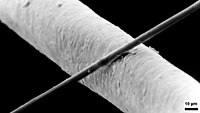
Photo from wikipedia
Abstract The compressive dynamic modulus (E*) and the flexural modulus (MF) of an asphalt mixture are two of the main criteria in structural design and evaluation of flexible pavements. The… Click to show full abstract
Abstract The compressive dynamic modulus (E*) and the flexural modulus (MF) of an asphalt mixture are two of the main criteria in structural design and evaluation of flexible pavements. The correlation between these properties and the characterisation of their trends indicates a dynamic response of the asphalt concrete mixtures. In this study, a non-dimensional compressive dynamic modulus index (φE*) and a non-dimensional flexural modulus index (φMF) are proposed as ways to characterise the trends of changes of the dynamic modulus at different temperatures and frequencies. Analysis of Variance (ANOVA) and Ridge Regression were used in analysis of different variables of experiments and statistical modelling, respectively. ANOVA results showed that the proposed parameters are function of the temperature, frequency, and the interactions. Also, the analysis of trends showed that the values of φMF converge at 3% as temperature increases, while only a decreasing trend was observed for φE*. Furthermore, the correlation between φMF and φE* depends on the type of binder. The effect of binder type can be seen in the master curves. Furthermore, the analysis showed that the values of MF are at least 75% of E*, so this can be used as proximity factor to convert MF into E* for use in mechanistic pavement design. In addition, a statistical predictive model was proposed as function of MF, temperature and frequency. The outputs showed that MF and temperature at the frequency domain have significant effects on E* with a high correlation. In conclusion, the proposed parameters and the model can be used as a basis for development of a universal predictive model of dynamic modulus through trends of changes and material properties.
Journal Title: Construction and Building Materials
Year Published: 2021
Link to full text (if available)
Share on Social Media: Sign Up to like & get
recommendations!